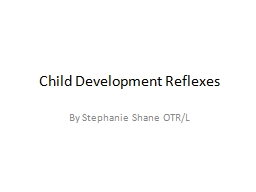

By Stephanie Shane OTRL Here is a great video to watch in order to learn about those primitive reflexes httpswwwyoutubecomwatchvvdiCep6OStA Rooting Reflex birth to 3 months httpwwwyoutubecomwatchvv7Yjg2soc ID: 1014076
Download Presentation The PPT/PDF document "Child Development Reflexes" is the property of its rightful owner. Permission is granted to download and print the materials on this web site for personal, non-commercial use only, and to display it on your personal computer provided you do not modify the materials and that you retain all copyright notices contained in the materials. By downloading content from our website, you accept the terms of this agreement.
1. Child Development ReflexesBy Stephanie Shane OTR/L
2. Here is a great video to watch in order to learn about those primitive reflexes. https://www.youtube.com/watch?v=vdiCep6OStA
3. Rooting Reflex (birth to 3 months)http://www.youtube.com/watch?v=v7_Y_jg2soc Reflex consisting of head-turning and sucking movements elicited in a normal infant by gently stroking the side of the mouth or cheek
4. Galant Reflex (birth to 3 months) http://www.youtube.com/watch?v=-vBZesEaYYs, http://www.youtube.com/watch?v=bswn56Qg_XMReflex elicited by holding the newborn in ventral suspension (face down) and stroking along the one side of the spine. The normal reaction is for the newborn to laterally flex toward the stimulated side.
5. Galant Reflex Cont.
6. Suck Swallow Reflex (birth to 6 months)Refleck elicited by rhythmic sucking and swallowing movements in an infant when a finger or nipple is placed in the mouth.
7. Traction Reflex (birth to 6 months)http://youtu.be/ohQoESVbRpYThis reflex is elicited by pulling to a sitting position. The head and shoulders are flexed forward and the arms are flexed. The baby actively helps himself to get to the sitting position by pulling with the arms. Also notice that the legs are flexed at the hips and are off the mat as the baby pulls himself to sitting. On being laid back down to the supine position, the baby doesn’t flop back, but is able to control the lowering of his head and trunk to the mat.
8. Traction Cont.
9. Moro (Birth to 6 months)http://www.youtube.com/watch?v=PTz-iVI2mf4Reflex elicited by a sudden loud noise, such as by striking the table next to the child, or raising the head slightly and allowing it to drop. A normal response consists of flexion of the legs, an embracing posture of the arms, and usually a brief cry. Also called startle reflex.
10. Moro Reflex Cont.
11. ATNR (Birth to 6 months)http://www.youtube.com/watch?v=pxrnFKwKJUcIt is also known as the "fencing reflex" because of the characteristic position of the infant's arms and head, which resembles that of a classically trained fencer. When the face is turned to one side, the arm and leg on the side to which the face is turned extend and the arm and leg on the opposite side flex.
12. ATNR (Cont.)
13. STNR (6 months to 12 months)http://www.youtube.com/watch?v=eDfWFiEb8ikThe STNR is not a primitive reflex; it is a bridging or transitional reflex. It is an important developmental stage that helps the baby transition from lying on the floor up to being able to creep/crawl. To be able to do this the baby needs to have successful in unlinking the automatic movement of the head from the automatic movement of the arms and legs.
14. STNR (Cont.)
15. Palmar Reflex (Birth to 6 months)Flexion of the fingers following tickling of the palm.
16. Tonic labyrinthine reflex http://www.youtube.com/watch?v=75HOIjFx1MEWith this reflex, tilting the head back while lying on the back causes the back to stiffen and even arch backwards, the legs to straighten, stiffen, and push together, the toes to point, the arms to bend at the elbows and wrists, and the hands to become fisted or the fingers to curl.
17. Tonic labyrinthine reflex (Cont.)
18. Plantar Grasp (Birth to 9 months)http://www.youtube.com/watch?v=WW0ewjPASpgA reflex characterized by the flexion of the toes when the sole of the foot is stroked gently.
19. Landau Reflex (3 months to 2 years) http://www.youtube.com/watch?v=jEDixMrg1nwRefers to position of the infant when held horizontally in the air in the prone position
20. Labyrinthine Optical Head Righting A reflex that corrects the orientation of the body when it is taken out of its normal upright position. It is initiated by the vestibular system, which detects that the body is not erect and causes the head to move back into position as the rest of the body follows.
21. Parachute (4 months and persists)http://www.youtube.com/watch?v=sJyH2TjoNhI, http://www.youtube.com/watch?v=sJyH2TjoNhIAllows accurate placement of LE in anticipation of a surface